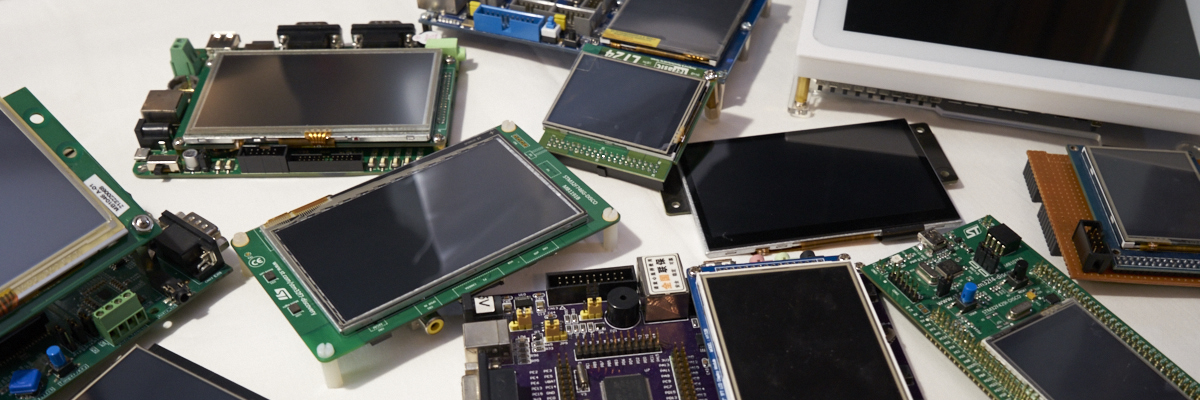-
Posts
2,656 -
Joined
-
Last visited
-
Days Won
2
Content Type
Forums
Store
Downloads
Blogs
Posts posted by Joel Bodenmann
-
-
I might have a look at this in the meantime.
Could you provide the exact font you used (ideally both the font source file (if possible due to licensing) as well as the output of the font converter).
-
We're currently in the process of migrating our git server.
Up until now, we were running Gogs but we're changing over to Gitea.Any user accounts with last activities older than 6 months will not be migrated to the new server.
If you'd like to get an account on the new git server (once migration is completed) please get in touch with us. -
Thank you for bringing this to our attention. Any form of feedback & possible bug report is welcomed

I'll be working the STM32LTDC driver in an upcoming project (few days/weeks from now). I will look into it then.
-
Thanks, we will look into this!
-
Thank you for bringing this to our attention!
Can you supply a minimum test-case that allows reproducing the bug(s) and corresponding patch(es)?
-
I haven't had time to check out your code yet - just the video. Looking good!
5 hours ago, uriy said:My aim was to show for other persons that it's possible to do. Because thay told before it's impossible.
What was their reasoning that it wouldn't be possible?
if you like we might be able to improve this together and eventually put it into the official µGFX library so it's supported out-of-the-box

-
For paid support options/discussions, please contact us via e-mail: info@ugfx.io
-
Hi!
As you stated the existing text edit widget only allows for one line of text.
The proper way of doing this is creating a new widget called MultilineTextedit and implement the functionality. It might make sense to use the exsting Textedit widget as a base for this (i.e. copy-paste & modify).
Other than the API documentation you can find documentation on creating your own widget here: https://wiki.ugfx.io/index.php/Creating_a_widgetAlternatively we can implement the widget for via paid support.
-
Hello & welcome to the µGFX community!
Yes that is still true. If you purchased an µGFX 2.x unlimited commercial license you can still use any 2.x release without any additional costs. This also applies if it's a new/different project or product as long as the license holder noted on the licensing document is executing the development/sale.
-
@inmarket any insights from your side?
-
The FT6x06 driver was contributed by a community member. It's likely that not everything in there is optional.
We welcome any kind of contribution to improve the state of community-supplied drivers

-
What GINPUT driver are you using?
This might very well be a driver "problem" (or feature).Can you reproduce the problem when you take you application code and compile it into a native Windows, Linux or MacOS application?
-
Hello & welcome to the µGFX community!
There are various ways of achieving this. For example, you can have a look at the /demos/applications/notepad demo which is a small paint-like application. To draw without handling the touch (mouse) inputs through widgets. Instead, it uses ginputGetMouseStatus() to retrieve the current mouse status.
You can use the GTIMER module to implement the screen timeout easily.
-
Did you manage to get this working?
-
In that case I'd recommend to adjust whatever GDISP driver you have to handle that adjustment for you.
How to do this depends on the GDISP driver model used but the overall idea remains the same: shift each pixel before the display controller gets access to it. -
Hi,
I'll have to look into this at a later point but the mouse wheel is definitely not supported as of now. You should be able to click on the up and down buttons though.
Controlling the list via the keyboard requires linking/setting-up the keyboard keys to the list widget using the GINPUT module. -
Hi,
Check the return code of gdispImageOpenFile(). It will tell you whether the image was loaded properly.
The widget will not display the image if it wasn't loaded properly.In general I'd recommend you making sure that you can display the image using the imagebox widget before attempting to insert it into the list widget as this makes it easier to ensure that there are no underlying problems with the filesystem, image decoders and similar.
-
Can you elaborate a bit on what you want to achieve? It this offset desired to be global to everything the display displays or just for certain widgets? Also, is this a permanent measure or should this offset change during runtime?
If this is just a measure to align the UI of a machine with a display behind a panel I would recommend modifying the GDISP driver directly. This way your application remains unchanged and upgrading to future versions of µGFX will not require any changes.
-
On 22/01/2021 at 00:07, br64 said:
Where might I find info on how to set everything up on a Win10 environment?
There's a getting started guide available here: https://wiki.ugfx.io/index.php/Your_First_Compile_-_Windows
Keep in mind that µGFX is a library. It expects you to have a working development environment to which the µGFX library can just be added.@br64you can furthermore get free support on this community board or obtain a commercial support package.
I'll close this question for off-topic.
-
Hello & welcome to the µGFX community!
The µGFX-Studio is not publicly available.
-
Hello & welcome to the µGFX community!
This is a good way to get started: https://wiki.ugfx.io/index.php/Getting_Started
Especially the "Integrate uGFX" section would be of your interest. -
Thank you for bringing this to our attention. This is now resolved.
This was an artefact from a host migration - everything has been migrated except of the git server. We'll do that in the next few weeks (possibly over the new year's period).
-
The current µGFX release (v2.9) introduces new types to make the interface more consistent and future proof. However, there's a define named GFX_COMPAT_V2 which makes the "old" types still available. This macro is by default on/enabled (in the main configuration file). Therefore, using the existing micropython port with the latest µGFX release should be a comparably easy task.
Other than that: We're happy to help where we can. This forum is always at your disposal

We'd certainly like to see an updated/active/maintained micropython port for the µGFX library.Late answer to your initial post: The badge is STM32L4 based.
-
Hello and welcome to the µGFX community!
The EMF2016 badge team used µGFX and created a micropython port for it: https://badge.emfcamp.org/wiki/TiLDA_MK3/ugfx
Most likely that port was not maintained after but should certainly be a good starting point.
https://community.ugfx.io/topic/521-micropython-name-badge/



A couple bugs in the win32 display driver
in Development and Feedback
Posted
I am working on reproducing this. Unfortunately, I was unsuccessful so far.
Here's my simple test case following your pseudo code:
When running this, the window (display) shows the image as expected without any defects.
Am I missing something obvious here?
For reference, here is a ready-to-run Win32 project with the code shown above and the corresponding asset(s): win32_blit_test.zip